Evolutionary processes operate over thousands of years. Historical processes operate over shorter time spans. Willem Koops illustrates how children and childhood have been viewed in modern Europe and western thinking, from the 18th century Enlightenment and the works of Kant and Rousseau onwards. Rousseau’s book Emile influenced later educators, such as Pestalozzi, and psychologists such as Piaget. In the second half of his chapter, Koops especially considers the perspectives of historians of childhood, such as Aries. Aries argued that childhood was a modern invention. Although many psychologists have dismissed Aries’ approach, Koops argues that it cannot be totally discarded; and he debates too the arguments about how the advent of the mass media have changed childhood so that it is perhaps “disappearing.” Certainly the internet is radically changing the experiences of children and young people, in ways that we cannot fully foresee (see also Part X).
There is an important sociological literature on child development, which takes fuller account of the wider societal factors in the ecological model (see also Chapter 8). In her chapter, Dimitra Hartas discusses what she calls the neoliberal restructuring of society (the growth of unregulated markets) and how the resulting inequality impacts on children, and on parents and teachers as main agents of socialization. Family policy directives tend to privatize social problems by locating them within the family, but families have different levels of access to various forms of capital and resources. Good parenting has become a key to upward social mobility, with more middle‐class parents engaging in intensive parenting, to some extent taking over academic aspects of socialization; while teachers are now expected to deal with issues of well‐being, traditionally assigned to parents. The privatization of public spaces also impacts directly on children, for example on opportunities to play (see also Chapter 28). Inequality can impact well‐being and mental health by stressful social comparisons and by the erosion of social trust and cohesion.
Hartas’ analysis mainly focusses on western countries and the “global north.” Anthropologists have long studied childhood in a full range of societies, including the work of pioneers such as Mead (who did in fact have a master’s degree in child psychology, before developing a career as an anthropologist). In her chapter, Heather Montgomery delineates two different “anthropologies of childhood.” The more traditional view described childrearing practices, providing cross‐cultural perspectives on insights often drawn from psychology on how children learn and develop. Work by the Whitings on the Six Cultures studies, and later LeVine and Lancy, are in this tradition; as well as work from evolutionary theorists, notably Konner on hunter‐gatherer childhoods (see also Chapter 4). However, a different tradition emerged, linked to work by sociologists such as James and Prout, and the New Social Studies of Childhood movement, especially from the 1990s. These theorists saw children as agents, social actors, and informants, rather than as passive recipients of socialization practices. This repositioning has been largely welcomed; and the emphasis on children’s own rights and agency is reflected in the United Nations Convention on the Rights of the Child. But a more controversial idea is that childhood is a social construction rather than a universal biological entity (cf. Chapters 2, 3, and 4). Montgomery ends by suggesting some reconciliation of the two traditions, making use of cultural‐ecological models and Bronfenbrenner’s bio‐ecological model of human development (see Chapter 8).
CHAPTER TWO Behavioral Genetics
Darya Gaysina
Why are there differences in children’s social development even from the first weeks of their lives? Why can these differences be seen among children growing up in the same family? What are the origins of individual differences in social development, as well as in other behavioral traits? These are the main questions that behavioral geneticists try to address.
Nowadays, it is widely, even if not universally, accepted that individual differences in behavior are resulted from both genetic influences (Nature) and environmental influences (Nurture), that play an important role from the moment of conception throughout the life span. Moreover, Nature and Nurture do not act in isolation, but co‐act through complex gene–environment interplay, and jointly contribute to the whole variety of psychological characteristics (e.g., temperament, cognition, and emotions) of each person, and to individual differences in these characteristics that exist in the population.
Behavioral genetics is an interdisciplinary field that combines approaches of genetic and behavioral sciences to explore: the role of genetic factors; the role of environmental factors; and the role of gene–environment interplay, to better understand the origins of individual differences in social development and other psychological characteristics. This chapter focuses on key concepts in behavioral genetics, and on recent findings from genetically informative studies, such as twin, adoption, and molecular genetic studies, in relation to child social development. Specifically, we will explore relative contributions of genetic and environmental influences on typical and atypical child social development, and how these influences may change during development. We will discover how specific genetic factors contribute to child social development, and how these genetic effects can be modified by environmental influences. We will also find out how our genetic makeup shapes our environmental experiences. Finally, we will discuss how the findings from behavioral genetic research can be used in practice, in order to help children, families, and professionals working with children.
The Role of Genetic Factors in Social Development
In the past few decades, tremendous progress has been achieved in our understanding of the role of genetic factors in human development. The breakthrough discovery of the human genome in the beginning of this century was a milestone in genetic investigations of human health and behavior. The human genome consists of a molecule of DNA (deoxyribonucleic acid), which is built with three billion nucleotide base pairs. There are four different types of nucleotides – adenine (coded by A), cytosine (C), guanine (G), and thymine (T). These four nucleotides are organized in a specific sequence (e.g., ACTTGACCC…). Approximately 2% of the sequence represents genes – the regions of DNA that encodes for proteins.
The DNA sequence (including gene regions) is practically identical for all people, with less than 1% of the sequence varying among people. There are different types of DNA variation, also known as polymorphisms or mutations. The most common type of genetic variation is a change in just one nucleotide; this is called a single nucleotide polymorphism (SNP). SNPs occurs with a frequency of 1 in 1000 nucleotides. In addition, other more substantial changes can occur in the genome, including substitutions, insertions, and deletions of several nucleotides (Plomin et al., 2013). As a result of these DNA variations, each person has a unique genetic makeup. Any of the millions of polymorphisms in the human genome can contribute to individual differences in a particular human trait. Therefore, DNA variation is a major contributor to observed individual differences in various traits.
As widely accepted today, psychological traits are influenced by multiple genetic variants with small effects (a phenomenon called polygenicity). In addition, every polymorphism may contribute to a large number of traits (a phenomenon called pleiotropy). In recent decades, the fast development of advanced technologies and analytical tools has made possible investigations of complex genetic architecture of psychological traits. However, progress with identification of genetic factors for various traits has turned out to be slower than initially expected.
Читать дальше












